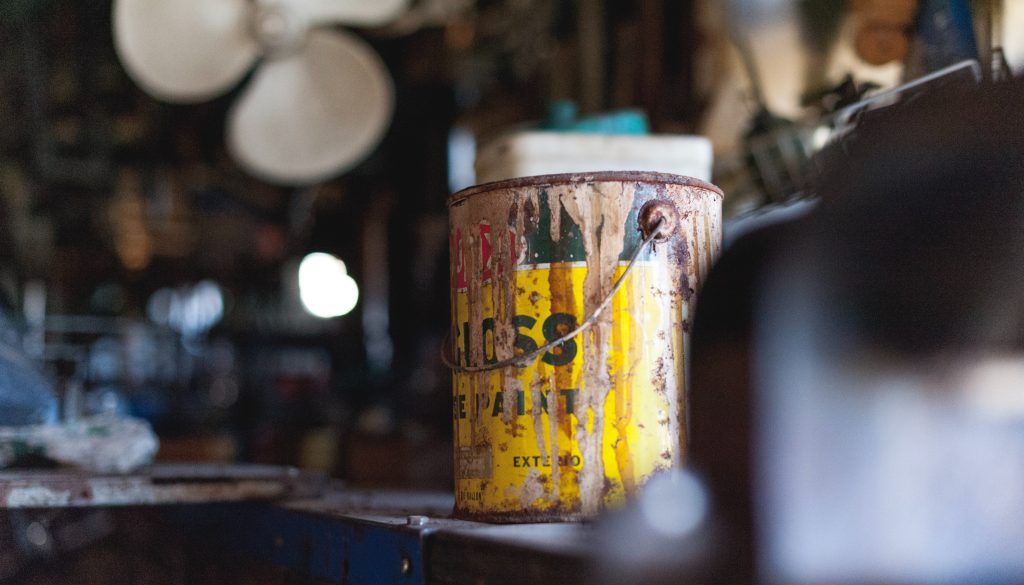Paint is an essential part of any home improvement, decoration, or renovation project. Without the correct application of paint, the desired aesthetic appeal is unlikely to be achieved.
However, when undertaking any painting work, the problem of properly disposing of old paint arises. With the wrong disposal methods, the environment can become contaminated with hazardous chemicals, particularly if oil-based or lead-based paints have been used.
Therefore, it is essential to understand the best approaches to disposing of old paint to avoid running into any legal or environmental issues. Continue reading to understand the factors surrounding paint disposal.
What Is Paint?
Paint is a liquid or paste made up of various ingredients, such as pigments, binders, and fillers. It is typically applied to a surface in order to change the colour, texture, or protection offered.
Depending on the paint type being applied, a variety of brushes, rollers, and sprays can be used to apply it. Paints can be broadly categorised into two main types: water-based and oil-based.
Water-Based Paints
Water-based paint is the most common type of paint used today. It is made up of a mixture of water, resins, and acrylic binders. The advantage of using water-based paints is that it is easier to apply and cleans up with water.
It also tends to be less toxic and less flammable than its oil-based counterpart.
Oil-Based Paints
Oil-based paint is created using a combination of petroleum-based products and natural oils, such as linseed, soybean, or tung oil. Its primary advantage is that it tends to have a longer-lasting finish.
However, it is often more difficult to clean up after and can be more damaging to the environment.
Lead-Based Paints
Lead-based paint was once widely used in the United Kingdom but is now largely outlawed. It is a health hazard as lead particles can be ingested through inhalation, ingestion, or absorption through the skin.
Environmental Concerns
The disposal of old paint is a serious environmental concern, as paint can contain a variety of hazardous chemicals, such as volatile organic compounds (VOCs). These substances might be discharged into the environment through improper disposal, potentially contaminating water and air sources.
Legal Considerations
One must also consider the legal implications of disposing of old paint. Old paint cannot be disposed of in household waste bins or landfill, as it can pose a hazard to public health.
Approaches to Disposal
The best approach to the disposal of old paint is to use a combination of methods. Specific to the type of paint being disposed of, here are some ways of properly disposing of old paint:
Reuse
Reusing old paint is an ideal way to get rid of it, as it eliminates the need to dispose of it. Any unused water-based or oil-based paint can be saved or given away for use in other projects.
Additionally, any nonprofits or community groups may be interested in taking donations of paint due to the cost savings associated with it. A number of businesses also offer a paint recycling service where customers can drop off their paint for reuse in new products.
This eliminates the need for the old paint to be disposed of and also helps reduce waste. Online auction sites may also be a good place to sell unused paint, with sites such as eBay and Marketplace making it easy to find a buyer for any leftover paint.
Recycle
Recycling oil-based paint is a great way to reduce the amount of waste entering landfills. It’s an environmental solution that can help us preserve our natural resources. Recycled paint can be safely reused in a variety of ways.
The process of recycling oil-based paints is relatively straightforward. The paint must first be sent to a specialist recycling facility, where it is assessed for hazardous materials.
The paint is then processed and broken down into its component parts—oils, solvents, pigments, and binders. These components are then filtered and combined to form a new paint product.
This new paint is then tested for quality and safety to ensure that it meets all applicable standards. The new paint can then be made available to consumers and other businesses, reducing strain on natural resources while still providing a quality product.
Recycling oil-based paint is a win-win—it reduces waste while creating a safe, usable product.
Dry Out
Drying out water-based paint is a safe and effective way to dispose of it. By combining the paint with materials like kitty litter, sawdust, or newspaper, the paint is able to dry out and harden, enabling it to be safely discarded.
The first step in drying out paint is to thoroughly mix it with the desired material, such as sawdust or kitty litter. Once properly mixed, the paint should be left to sit in an airtight container, such as a sealed bucket or rubbish bag, for a few days.
During this time, the paint will slowly evaporate, and the absorbent material will trap the pigment and solvents–resulting in a hard solid.
Once the paint is fully dried out, it can be safely disposed of in a household rubbish bin. It’s important to remember that dried-out paint is still a hazardous material and should not be disposed of in any way that may put people or the environment at risk.
Hazardous Waste Disposal
Hazardous waste disposal is an important way to dispose of any material that is considered harmful to the environment or human health. To safely dispose of paints containing toxic substances, the best option is to take them to a hazardous waste disposal site.
Here, the old paint can be disposed of in a way that reduces the potential impact on public health and the environment. It is important that hazardous waste is handled and disposed of properly to prevent it from entering the environment and causing harm.
At a hazardous waste disposal site, the paint is disposed of according to specific protocols, such as sorting and packaging it, as well as utilising appropriate waste disposal methods like secure incineration or other special treatment processes.
The hazardous waste is then safely moved to a landfill, where it is disposed of properly and monitored for long-term safety. Onsite staff is also trained to ensure proper hazardous waste disposal practices are followed on a regular basis.
In addition to taking the paint to a hazardous waste disposal site, other methods of disposal, such as recycling and reusing the paint, should be explored first. This can save time, effort, and money, and it reduces the amount of hazardous waste in the environment.
When all else fails, proper disposal at a hazardous waste disposal site is the best option.
Conclusion
It is essential to properly and safely dispose of old paint. Depending on the type of paint and its composition, the disposal method will vary. By understanding the approaches to disposal, one can ensure any old paint is disposed of in the correct manner, thus avoiding any legal or environmental issues.
Enviro Skip Hire is a family-run skip hire and aggregate company servicing Staffordshire. We can assist you if you need to hire a skip in Stafford or dispose of hazardous waste like paint.
As a licensed waste management organisation, we have many years of experience dealing with the disposal of hazardous waste. Because we are specialists in this area, we can assist our clients in securely and environmentally disposing of this particular waste. Contact us today to learn more!




